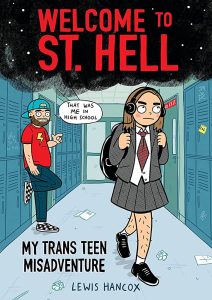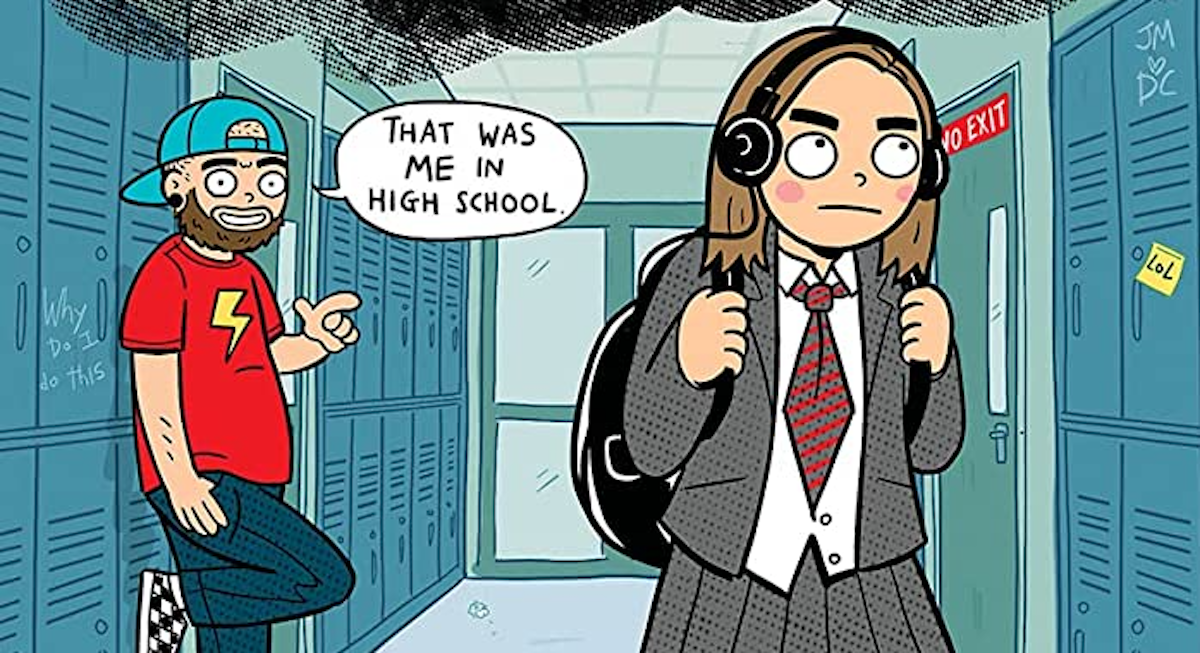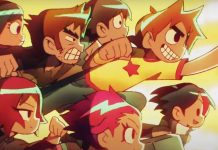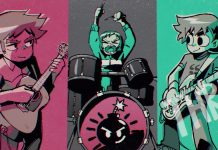
By Jim McDermott
Among the Eisner nominees for Best Graphic Memoir is Welcome to St. Hell: My Trans Teen Misadventure, Lewis Hancox’s memoir about his childhood journey to transition. Profoundly empathetic, the book features teenage Hancox and family in conversation with the Lewis of today as they take their first steps toward self-acceptance.
For Hancox, a comedian who had never published a comic before, it has been an incredible journey.
Congratulations on the Eisner nod. It’s well deserved.
It’s my first book. I just can’t believe it. To be nominated for the Eisner Award is like the peak of everything. I just never would have predicted it.
It’s clear from the book that you’ve always been interested in drawing.
Yeah, as soon as I could pick up a pen as a little kid I was just drawing. I used to be obsessed with Hanna-Barbera: Scooby-Doo, Tom & Jerry, and all that. That was my dream, to one day create my own cartoons.
As I got older, it was always there in the back of my head, but other things take over. For me, I guess it was my transition. And then I got more into filmmaking. But the drawing was always there, I would just do it for fun.
In lockdown, I thought I needed to do something with my time because my film work had all dried up. So I spent the whole of lockdown drawing the book. I just did it for my own sake. I thought, if it gets a little indy publisher and reaches a few people that’d be enough. I didn’t expect it to get picked up by Scholastic!
I’m working on the second book now, Escape from St. Hell, which will be out next year. It’s so strange. This is a career path I’ve always wanted, but I never expected to get there.
It’s amazing that the horror of lockdown could have allowed this really special thing to happen.
I know. It was a very tragic time. But it kinda gave me the breathing space just to create something like this.
When you were growing up, were there storytellers who inspired you?
One that sticks out for me is Calvin & Hobbes. Do you remember those books?
My profile on Twitter is “Part Time imaginary tiger.” ☺
I was obsessed with them.
What was it about Calvin & Hobbes that you loved so much?
Inside I felt like a boy, but there was no representation for a trans boy. So I used to really connect with other boys in books and films. Like the Home Alone movies, I used to feel like I was Kevin. Any sort of boy characters I would really kind of wish they were me.
I’m an only child as well. You know how Calvin created his own world, and Hobbes came to life—that was kind of how my mind worked. I spent a lot of time on my own creating my own characters and worlds.
It’s funny, Welcome to St. Hell reminds me a bit of Calvin and Hobbes in the way that there’s the Future Me with my teenage self.
Future You is like the Hobbes to your younger self.
Exactly, Hobbes was the reassurance to Calvin, wasn’t he?
Growing up I never had the reassurance that I would be okay and that I could grow up to be a man. So when I wrote this, it really was like writing a love letter to my teenage self. It was the book that I wish I had growing up. And I wanted to tell it in a funny, relatable way, with all of the music and the skateboarding. I think this is the kind of book as a teenager I would have loved. And I would have realized it’s not weird to be trans.
Another story that inspired me was Scott Pilgrim Versus the World. I loved the film, and I loved the comics. At one point I thought if I was going to create a comic book, it would have to be about superheroes. Scott Pilgrim was the first time I realized I can create comics about real life. Yes, they have a fantasy twist on them, but that’s what I love—basing it on real life but adding a fantasy twist.
Was Future You in the book right from the start?
When I first started with the seed of the idea of the book, I started just drawing memoires. I didn’t draw it chronologically, I just drew the most important memories that stood out to me of being a teenager. One of the first scenes I drew was me on my first day of high school having to pick between the pants or the skirt. I think about that a lot.
Then I probably had about 30-40 pages of memories. And in a discussion I had with my agent, I said, I want people to see me now and see how I’ve got where I am now, She was like, Well just put yourself in there. And the thing is, I have done a few YouTube videos in the past with this exact thing, older me talking to younger me. As soon as I put me in there the story came together.
I think we all imagine what we could say to our younger selves. And then with me, there’s the extra layer that younger me was living as a girl. So I’ve always fantasized about what those conversations would be like.
If I hadn’t put Future Me in there and just told the story of Teenage Me, it would have been left open, Do I ever become happy? And that’s just not the message I wanted to get across. I wanted to show the hope at the end but not shy away from all of the dark times.
The relationship between Future You and Teenage You is really fun, too. I love that sometime Teenage You has absolutely no time for you.
Genuinely I don’t think teenage me would have listened. Teenagers’ mission is to fit in, and I just wanted to fit in. I was so defensive about it back then. There’s that scene where this trans documentary comes on the TV, and my mum turns to me and says, Do you still have these feelings? And I shout back No, no I’m not weird!
That really happened. I got to that point where I was burying things so deep that there was no changing my mind. So I just kind of played with that. Teenage Me has to do what Teenage Me has to do to figure out who I am.
Having Future You present as a character in the story really helps us appreciate the idea of everyone being on their own journeys. There’s a moment where Future You says to your mom, “Do you ever miss calling me by my old name?” It’s just a powerful moment.
Something that I learned on this journey is that everyone else transitions with you. You’re not going through something by yourself. Any big thing we go through is going to be hard for the people that love us.
So I wanted readers to empathize with the other people around me. I also want the book to be for parents, teachers, and friends. I wanted to show the struggles and how they ended up learning to accept me.
I just fumbled through it all. That’s how my family describes it too. But no matter the arguments I had with family and friends, the main thing is we didn’t abandon each other. We didn’t have to all align our views all the time. We fumbled through it together.
I’m struck by how generous you are in the book. At times the people you love let you down, but there’s never a sense of you digging at them. You’re always interested in trying to understand what they’re thinking and doing.
Thank you. I think it’s so important not to write people off instantly just because they don’t understand. A running theme of my life has been bringing people on the journey with me. I’ve never pushed people out, I’ve wanted people to learn with me. And I think that I am fortunate to have such amazing family and friends that do support me. Sometimes you just need to give people the time and space to learn to understand.
I was once at a point where I didn’t understand either, even though I was trans myself! There was a time that I had no clue.
Another part of the conceit of having Future You moving in and out of the narrative is that we get these moments when characters question the way you’re representing them. It’s fascinating that you would give others so much autonomy within your memoir.
All of those quips have come from real things. I showed my mum and dad the book, and the things they said are what they really said. As soon as I got their reactions I was like, well that’s going in the book.
I wanted to recognize that anyone who tells a story tells it from their point of view. And I wanted other people’s perspectives in there. They’re characters, but they’re real people.
Did you actually interview other characters, like Jess and your grandparents, too?
I did. Actually what I did was first I wrote a little rough interview, sort of predicting what they’d say before I interviewed them.
I got it right in some circumstances, but there were actually some things they said that really shocked me. And I was like Oh my god I’m so glad I’ve just chatted to you, because I would never have thought that you’d think that.
Can you give me an example?
This is one that stands out to me: Jess was always the one growing up that was the cool confident one. I felt like she knew the right way to live life. But when we chatted, she said, Lew, I was always so jealous of you. I used to think you were so cool. I used to watch you skateboarding with all the boys and wished that I could do that too.
It really shocked me. At the time I was skateboarding with all the boys thinking oh God I bet I seem like a weirdo because I’m trying to be one of the lads.
Welcome to St. Hell is a big book, 300 pages. Was it hard to figure out what to include and what to cut?
At times, yes, I did have to make some decisions. Future Me could have really popped up on any page to say something. It’s about picking the moments. I wanted people to just get lost in Teenage Me’s world.
Artistically, was the style you chose for the book your natural drawing style or story-related?
I’m a real perfectionist. When I was younger and I tried to draw more of this serious superhero style and get the bodies more anatomically correct, I used to fuss and fuss over a page. It would take me forever to do one drawing.
With this book, I tried to let go of a lot of my perfectionism. I realized this book is not about the artwork being top-class artwork, it’s about the story. And actually what I found is that sometimes the more loose I keep a drawing the more personality there is to it, as well.
I kind of put myself in a teenage brain. I thought if I was to keep a comic diary, how would I do it? And I think that flowed through my pen when I did it.
Welcome to St. Hell has two endings: You at the clinic getting your first injection, and then the photos of you and your family. Why did you end it in these ways?
I felt like I had to take it to the point of my first testosterone injection. That’s what my whole book was building to.
I remember thinking This is it now, this is literally the start of my physical transition. It was really such a big moment in my life.
The family photos, I just felt like I really wanted to show that these are real people. And I just came to me like they’re all hung on a wall in my mum’s house.
It’s funny, I did that as almost an afterthought like they were bonus pages at the end. But the amount of people that have said they welled up at those pages. It’s really touching to hear. I think those are the ones where it hits home with people that this is a real story.
For many people who have transitioned, it’s important not to have their dead name or former self-referenced ever. But you don’t take that approach at all in Welcome to St. Hell.
I understand why a lot of trans people wouldn’t do that, and I’m not saying everybody has to. There was definitely a time in my life when I would have been more opposed to it. I think when I first started my transition, I was just so desperate for people to see me as this new person, to see me as Lewis, a man, I would not have done this.
It’s only now that I’m at a place where I’m so comfortable in myself and who I am. Giving people my old name, showing me before my transition, doesn’t make me less of who I am, it doesn’t make me less of a man, it doesn’t change who I am. The way I see it is I was always me inside.
That’s how I like to describe it, I’ve always been me, but just put into a tricky situation at the start. And so therefore there’s something that feels really empowering about being able to be so open, to show that this was me. I’m the same person, it’s just that back then I looked like this, I didn’t know who I was yet.
And when it comes to the name, I’m so at ease with myself I think it’s just a name. If Lois was a name for a boy too, then I could have kept it. it’s quite cool, it’s like Lois Lane from Superman.
I feel like a lot of these things that I’ve been through are not unique to me. Yes there’s that unique twist on them that I am trans, but I feel like if we all look back at our teenage selves, we all feel that we’ve all gone on our journey since then, and we feel like completely different people.
In the States we’ve had a lot of problems in recent years with censorship of books on queer subjects. Have you faced any of that in the UK?
Yeah, I have. It’s not something I really like to focus on, but yeah, I have had a certain backlash from people who are already anti-trans basically.
But even with these people that are really against the book and don’t understand it, I will never not be open to having conversations. I will never shun them. I don’t want to push anyone away. Whether it’s naïve or not, I’m always open to the possibility that people can learn and grow.
Congratulations again. Welcome to St. Hell is a really special book.
Thank you. I don’t think it will ever sink in. That’s probably a good thing in a way. I’ve just always wanted to tell stories and create characters. And that will never stop.
Welcome to St. Hell: My Trans Teen Misadventure is available at your local bookstore and/or comic shop now.










I discovered this book thanks to an Instagram ad of all things. I picked it up from my local library and fell in love. Such a lovely and powerful read. I feel like i grew with Lew as i read his journey. i recommend this book enough.
Comments are closed.